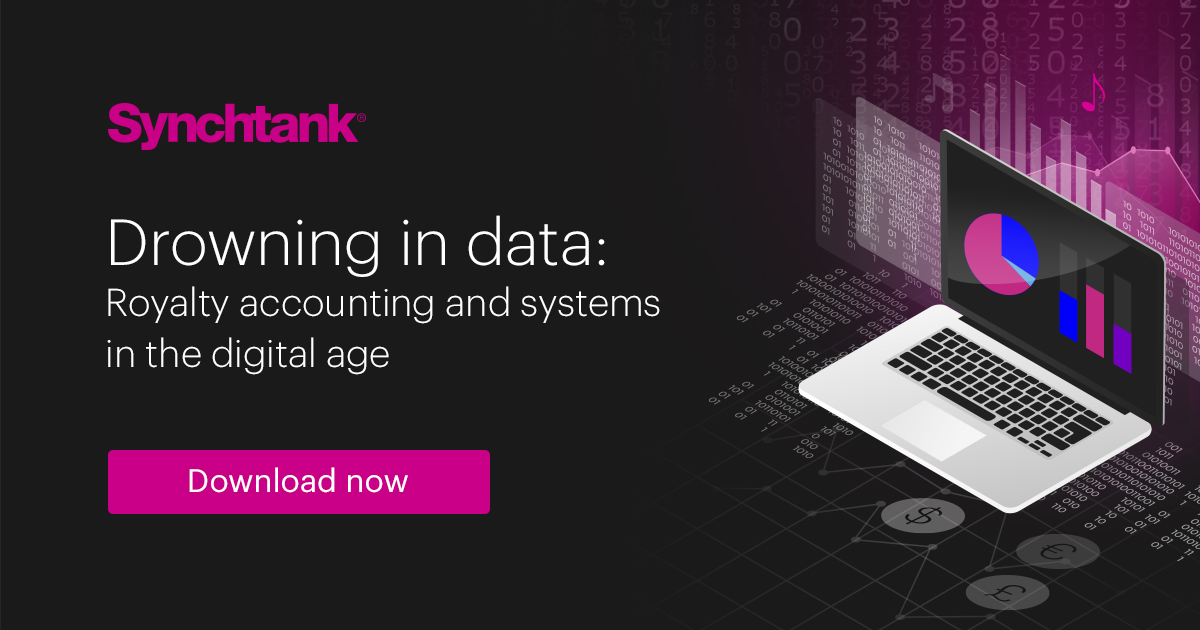Music publishers and CMOs are facing unprecedented volumes of data and increasingly complex rights and royalty payments. At our Data, Rights & Royalties Summit last week, a panel of experts discussed these challenges and the need for robust technology and cross-industry cooperation.
Watch the panel in full now or check out our key takeaways below:
Panelists:
- Mick Hayes – Director of Product Management
- ICE Michael Lau – President, AIMP NY Chapter / Operations Committee Member, The MLC
- Janet Landrum – Royalties Specialist, Synchtank
- Matt Phipps-Taylor – CIO, peermusic
- Moderator: Emma Griffiths – Marketing Manager, Synchtank
Key takeaways:
Data volumes are growing at an unprecedented rate
As the title of our royalties report Drowning in Data suggests, rights holders and their systems are now having to deal with ever rising volumes of data coming from an historic number of income sources.
Matt Phipps-Taylor, CIO of peermusic, described the dramatic growth the leading independent publisher has witnessed in recent years. “We’re processing something like 60 times the volume of data that we were processing 10 years ago,” he explained. “Over the last two, three years in particular, volumes have really accelerated, which is a bit scary because we are now talking about really substantial volumes of data.”
“Over the last two, three years in particular, volumes have really accelerated, which is a bit scary because we are now talking about really substantial volumes of data.”
– Matt Phipps-Taylor, peermusic
“10 years ago, as a medium sized publisher, you were processing a couple of million lines of data every period. Now it could be hundreds of millions,” explained Michael Lau, former COO/CTO at Round Hill Music and President of the AIMP’s New York Chapter.
According to the panel, this is putting a huge strain on industry systems and processes, many of which were not built for the digital age.
“When it [online] first started to come in as a business model, everyone tried to drop their existing mechanical physical product processing systems into online. That worked for low volume, high value, but we’re now struggling with the business models in streaming,” said Mick Hayes, Director of Product Management at ICE.
Both rights holders and CMOs now face the very real challenge of ensuring that their systems and processes are economically viable. “Each row of data that we have to process is worth a fraction of what it used to be, so it’s just not feasible to have people processing individual data lines,” said Phipps-Taylor.
“It’s going to have a lot to do with what system each rights holder has in place to handle all of it,” added Synchtank’s Royalties Specialist Janet Landrum. “It’s gonna make a huge difference in what the cost per line item will be for management and processing.”
Collaboration and consolidation is essential
While a single global database is not realistically achievable, the panel agreed that there needs to be more collaboration and consolidation of services.
Processing hub ICE, a joint venture between PRS, STIM and GEMA, is a great example of this. “There’s always been in the industry some data sharing of documentation of making sure different organizations know what the rights pictures are, but we’ve never, as an industry, looked at how we share information that might improve processing,” said Hayes. There are, as he explained, other societies joining together to combine their invoicing and processing rather than building individual systems. “I think if it’s going to take the strain moving forward, we’ve got to stop being competitive on some process elements.”
“I think if it’s going to take the strain moving forward, we’ve got to stop being competitive on some process elements.”
– Mick Hayes, ICE
Landrum pointed to ASCAP and BMI’s new shared data platform Songview as a welcome example of cooperation and collaboration among CMOs. “It’s nice to see BMI and ASCAP getting along and being more transparent about who’s holding these different pieces of the rights. You can get a nice overall view of where everything needs to be going and whether or not it’s correct.” she said.
“You’ve got a lot more collaboration now with ASCAP and BMI working together to combine this data rather than each rival trying to build their own systems,” added Hayes. “I think that is the direction the CMOs are working towards.”
“You’ve got to balance transparency with being able to manage that data.”
– Janet Landrum, Synchtank
The panel also discussed the potential for aggregating data to help lessen the load for rights holders. “We need the quality data to match the works and the recordings, but we need to look at whether we are doing enough aggregation in some of this data because there is a lot of duplication,” explained Hayes. “You’re just getting it [the same data] again and again, and that’s putting strain right across the value chain.”
On the flip side, explained Lau, by consolidating the data you may lose some of the transparency that allows you to identify inaccuracies. It’s all about finding the right balance, explained Landrum. “You’ve got to balance transparency with being able to manage that data. You’ve got to be able to aggregate it in some respects so that you’re not getting just immense volumes of lines.”
Legacy data and increasingly fragmented rights present huge challenges
As Phipps-Taylor pointed out, the music industry is plagued by data issues.
“What I call our data plumbing is notorious for being leaky, he explained, adding that CMOs have the opportunity to be real leaders in improving this plumbing. “They are large data managers themselves, and they can exert faster improvements than we can necessarily as individual rights holders.” He also commended CISAC for the improvements it recently made to its ISWC service.
Problems with data are further exacerbated by the increasingly fragmented nature of music rights. As Phipps-Taylor explained, the more people you add into the equation, the more chance there is for human error. “If there’s 15 writers who are registering that song at let’s say BMI, there’s 15 separate registrations for that,” said Lau. “But what if the song title is a little bit different on three versions, what happens? Three writers don’t get paid?”.
“There’s no cross industry tool, no common reference point, and I think that’s a major problem,” added Hayes, explaining that ICE is very focused on reducing the issues associated with putting this jigsaw together.
“It’s a joint effort and everybody has to contribute, but, from the rights holder perspective, that requires capacity to be able to address that.”
– Michael Lau, AIMP
The panel agreed that legacy data is by far the biggest challenge here and requires significant manpower and cooperation between various parties.
“It’s a joint effort and everybody has to contribute, but, from the rights holder perspective, that requires capacity to be able to address that,” explained Lau, also pointing out that legacy rights and now changing hands more frequently which further complicates matters.
“It’s hard enough for a publisher to function on a day-to-day basis just getting everything done and processed in a timely fashion, but being able to start these huge projects where you’re cleaning up legacy data is incredibly difficult,” said Landrum. “It’s human error and just lack of manpower and hours in the day.”
Blockchain technology has many limitations
As expected with any panel on data and rights, the potential of blockchain as a solution was also raised here.
“I’m a bit of a blockchain skeptic personally,” said Phipps-Taylor. “I think there’s some really interesting things that can be done with it, but I don’t think anybody has really come up with a compelling way to apply it to address any of the music problems.
Compared to say the financial services industry, he explained, the music industry doesn’t have the infrastructure in place to make this technology viable. “In music, the vast majority of our effort is spent going, is this the same thing as the thing you have? Is it my one or your one? Who owns this thing? We don’t have the solid backbone to get to a world where technology could be moving money around.”
“There’s too much that gets changed and blockchain is not designed to be quickly edited and changed.”
– Mick Hayes, ICE
Going back to the industry’s issues with legacy data, Lau explained that a lack of identifiers is also a barrier to the successful implementation of blockchain solutions. “A lot of old legacy songs don’t have ISWCs and a lot of sound recordings don’t have ISRCs, so that breaks the system right there,” he said.
“There’s interesting options for it, but not in this idea that you know all the metadata about a song and that sticks and it’s nicely protected all the way through the value chain,” explained Hayes. “There’s too much that gets changed and blockchain is not designed to be quickly edited and changed.” Hayes also pointed to the performance limitations of blockchain. “The performance of the blockchain technologies are nowhere near that at the moment for the throughput we need.”

